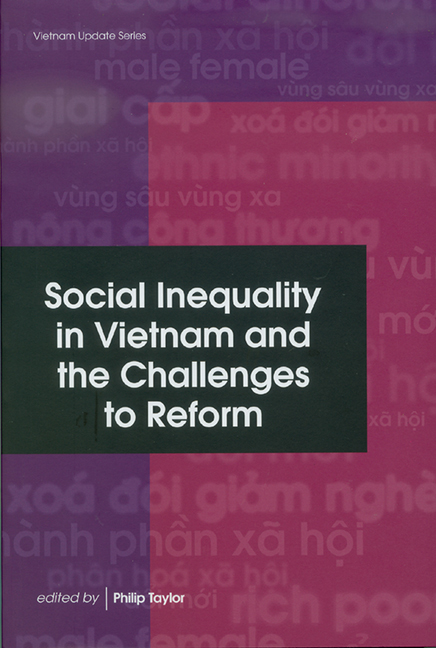Book contents
- Frontmatter
- Contents
- List of Tables
- List of Figures
- Preface
- Introduction: Social Inequality in a Socialist State
- 1 Vietnam's Recent Political Developments
- 2 Vietnam's Recent Economic Reforms and Developments: Achievements, Paradoxes, and Challenges
- 3 Behind the Numbers: Social Mobility, Regional Disparities, and New Trajectories of Development in Rural Vietnam
- 4 From Collectivization to Globalization: Social Differentiation in a Muong Ethnic Community of Vietnam
- 5 Political Capital, Human Capital, and Inter-generational Occupational Mobility in Northern Vietnam
- 6 Social Disparities in Vietnam: The Case of Poverty Reduction and Educational Attainment
- 7 Redressing Disadvantage or Re-arranging Inequality? Development Interventions and Local Responses in the Mekong Delta
- 8 The Politics of Land: Inequality in Land Access and Local Conflicts in the Red River Delta since Decollectivization
- 9 Female Garment Workers: The New Young Volunteers in Vietnam's Modernization
- 10 Class, Nation, and Text: The Representation of Peasants in Vietnamese Literature
- 11 Leisure and Social Mobility in Ho Chi Minh City
- Index
- About the Contributors
- Publications in the Vietnam Update Series
6 - Social Disparities in Vietnam: The Case of Poverty Reduction and Educational Attainment
Published online by Cambridge University Press: 21 October 2015
- Frontmatter
- Contents
- List of Tables
- List of Figures
- Preface
- Introduction: Social Inequality in a Socialist State
- 1 Vietnam's Recent Political Developments
- 2 Vietnam's Recent Economic Reforms and Developments: Achievements, Paradoxes, and Challenges
- 3 Behind the Numbers: Social Mobility, Regional Disparities, and New Trajectories of Development in Rural Vietnam
- 4 From Collectivization to Globalization: Social Differentiation in a Muong Ethnic Community of Vietnam
- 5 Political Capital, Human Capital, and Inter-generational Occupational Mobility in Northern Vietnam
- 6 Social Disparities in Vietnam: The Case of Poverty Reduction and Educational Attainment
- 7 Redressing Disadvantage or Re-arranging Inequality? Development Interventions and Local Responses in the Mekong Delta
- 8 The Politics of Land: Inequality in Land Access and Local Conflicts in the Red River Delta since Decollectivization
- 9 Female Garment Workers: The New Young Volunteers in Vietnam's Modernization
- 10 Class, Nation, and Text: The Representation of Peasants in Vietnamese Literature
- 11 Leisure and Social Mobility in Ho Chi Minh City
- Index
- About the Contributors
- Publications in the Vietnam Update Series
Summary
Having launched economic reforms in the 1980s, Vietnam became one of few economies in the world that experienced high and sustainable economic growth throughout the 1990s. High economic growth helped reduce its poverty rate significantly from well over 60 per cent in 1990 to around 29 per cent in 2002. Besides this impressive achievement, Vietnam has also significantly improved its already relatively good social indicators in the areas of education, healthcare, and life expectancy.
In spite of significant progress at an aggregate level, some disparities in social well-being exist across the country. Data available from the Vietnam Living Standards Survey 1998 (hereafter cited as VLSS 1998) indicates that the share of the population living below the national poverty line in the 12 poorest provinces was more than four times higher than that in the 12 most well-off provinces. Among the poorest provinces were those in the mountainous and remote areas, where a large proportion of the population consists of ethnic minorities (GOV 2003). While Vietnam's recent primary education net enrolment rates have increased considerably to over 90 per cent, the rates in the 12 bottom provinces in terms of primary enrolments are more than 20 percentage points lower than those in the top 12 provinces. Again, these bottom provinces are mostly among the poorest. A similar picture can also be seen when one goes from the national aggregate level to the provincial level in other social aspects such as healthcare, child mortality rate, or gender equality (WB 2003; UN 2003).
Using data from the Vietnam Household Living Standards Survey 2002 (GSO 2003a) (hereafter cited as VHLSS 2002) and other sources, this chapter will first provide an update of the overall social and economic situation in Vietnam in recent years (from 1998 to 2003), and then analyse social disparities in the areas of poverty reduction and educational attainment among different geographical locations and different groups of people, highlighting the underlying reasons for these disparities. Finally, based on the findings, the study suggests various social and economic policies to address the identified problems.
- Type
- Chapter
- Information
- Social Inequality in Vietnam and the Challenges to Reform , pp. 208 - 235Publisher: ISEAS–Yusof Ishak InstitutePrint publication year: 2004



